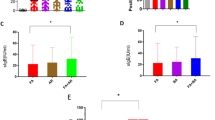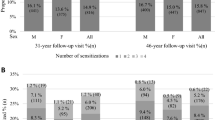Abstract
The association between house dust allergy and asthma has long been recognized, and it has been demonstrated that a major allergen in house dust is related to the presence of mites of the genus Dermatophagoides1. Using extracts of mite culture for skin testing, as many as 10% of the population and up to 90% of allergic asthmatics give positive immediate reactions2. Although mites may occasionally become airborne during bed-making3, it has also been demonstrated that they ‘secrete or excrete’ some allergen1. Recently, we have shown that up to three-quarters of the serum IgE antibodies to mites are directed against a major allergen—antigen P1 (molecular weight 24,000)4. Using a radioimmunoassay it is possible to measure the concentration of this glycoprotein in both dust samples and mite cultures. These measurements, which are reported here, show that more than 95% of the allergen accumulating in mite cultures is associated with faecal particles.
This is a preview of subscription content, access via your institution
Access options
Subscription info for Japanese customers
We have a dedicated website for our Japanese customers. Please go to natureasia.com to subscribe to this journal.
Buy this article
- Purchase on SpringerLink
- Instant access to full article PDF
Prices may be subject to local taxes which are calculated during checkout
Similar content being viewed by others
References
Voorhorst, R., Spieksma Boezeman, M. I. A. & Spieksma, F. Th. M. Allergic Asthma. 10, 329–334 (1964).
Morrison-Smith, J., Disney, M. E., Williams, J. P. & Goels, Z. A. Br. med. J. ii, 723–726 (1969).
Cunnington, A. M. & Gregory, P. H. Nature. 217, 1271–1272 (1968).
Chapman, M. D. & Platts-Mills, T. A. E. J. Immun. 125, 587–592 (1980).
Marsh, D. G. in The Antigens. Vol. 3 (ed. Sela, M.) 271–350 (Academic, New York, 1975).
Tovey, E. R., Chapman, M. D. & Platts-Mills, T. A. E. (in preparation).
Harper, G. J. & Morton, J. D. J. Hyg., Camb. 51, 374–385 (1953).
Austen, F. K. & Orange, R. P. Am. Rev. resp. Dis. 112, 423–436 (1975).
Brody, A. R., McGarth, J. C. & Wharton, G. W. N. Y. ent. Soc. 80, 152–177 (1972).
Author information
Authors and Affiliations
Rights and permissions
About this article
Cite this article
Tovey, E., Chapman, M. & Platts-Mills, T. Mite faeces are a major source of house dust allergens. Nature 289, 592–593 (1981). https://doi.org/10.1038/289592a0
Received:
Accepted:
Issue Date:
DOI: https://doi.org/10.1038/289592a0
This article is cited by
-
Structure/epitope analysis and IgE binding activities of three cyclophilin family proteins from Dermatophagoides pteronyssinus
Scientific Reports (2023)
-
Environmental Factors and Their Impact on Airway Diseases: Exploring Air Pollution, Indoor and Outdoor Allergens, and Climate Change
Current Pulmonology Reports (2023)
-
Microbial Communities of Stored Product Mites: Variation by Species and Population
Microbial Ecology (2021)
-
Clinical significance of dust mite allergens
Molecular Biology Reports (2020)
-
Update on House Dust Mite Allergen Avoidance Measures for Asthma
Current Allergy and Asthma Reports (2020)



